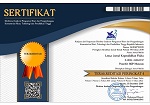The Effect of Inquiry Learning Model with Pictorial Riddle Method on Students' Creative Thinking Ability
DOI:
https://doi.org/10.33394/j-lkf.v7i1.1905Keywords:
Inquiry, Pictorial riddle, Creative thinkingAbstract
This study aims to determine the effect of inquiry learning models with pictorial riddle methods on students' creative thinking abilities. This research is a quasi-experimental (Quasy Experiment) with Nonequivalent Control Group Design. The research sample consisted of two classes, namely class X IPA 2 and class X IPA 3, each of which amounted to 30 students. The creative thinking ability test instrument consisting of 12 items and observation sheets was used to collect data in this study. The results of the study were analyzed using SPSS v-22 software for windows. The results showed that: 1) the average initial test scores of the experimental and control classes were 45.7 and 44.1 respectively; 2) the average initial test scores of the experimental and control class were 79.2 and 68.8 respectively; 3) homogeneity prerequisite tests show homogeneous data and normality tests show normally distributed data; 4) t-test results obtained Sig. (2-tailed) posttest data (0.00) is smaller than alpha testing (0.05), so the working hypothesis (Ha) is accepted. Thus, the inquiry learning model with the pictorial riddle method influences students' creative thinking abilities.References
Anggriani. (2017). Pengembangan Media Pembelajaran Berbasis Animasi Swish Max 4 Untuk Meningkatkan Kemampuan Berpikir Kreatif Siswa. Jurnal Ilmiah Pendidikan Fisika. 5(2), 1-8.
Dian. (2013). Pengaruh Penerapan Metode Inkuiri Dengan Media Pictorial Riddle Terhadap Hasil Belajar Siswa Dalam Pembelajaran IPA. Pontianak: FKIP Universitas Tanjungpura Pontianak.
Elizabeth, A., dan Sigahitong, M., M. (2018). Pengaruh Model Problem Based Learning Terhadap Kemampuan Berpikir Kreatif Peserta Didik SMA. Prisma Sains: Jurnal Pengkajian Ilmu dan Pembelajaran Matematika dan IPA IKIP Mataram, 6(2), 67-76.
Euis, S., Regina L., P., Ali, S. (2017). Pengaruh Metode Pembelajaran Pictorial Riddle Terhadap Keterampilan Berpikir Kritis Siswa SD Pada Materi Pelestarian Lingkungan. Jurnal Pena Ilmiah 2(1), 331 – 340.
Munandar. (2012). Kreaktivitas dan Keterbakatan: Strategi Mewujudkan Potensi Kreatif dan Bakat. Jakarta: PT Gramedia Pustaka Utama.
Nuriyanah, S. (2015). Pengembangan Kemampuan Berpikir Kritis Siswa Melalui Praktikum Sederhana. Semarang: Universitas Negeri Semarang.
Riduwan. (2003). Skala pengukuran variabel-variabel penelitian. Bandung: Alfabeta.
Sanjaya. (2010). Strategi Pembelajaran Beriorentasi Standar Proses Pendidikan. Jakarta. Kencana Prenada Media Group.
Sumantri., Mulyani., & Permana, J. (1999). Strategi Belajar Mengajar. Direktorat Jendral Pendidikan Tinggi: Depdikbud.
Trowbridge, L., W & Rodger, W., B. (1990). Becoming A Secondary School Science Theacer. United Ststes Of America: Prentice-Hall.
Downloads
Published
How to Cite
Issue
Section
License
Authors who publish with Lensa: Jurnal Kependidikan Fisika agree to the following terms:
- For all articles published in Lensa: Jurnal Kependidikan Fisika, copyright is retained by the authors. Authors give permission to the publisher to announce the work with conditions. When the manuscript is accepted for publication, the authors agree to automatic transfer of the publishing right to the publisher.
- Authors retain copyright and grant the journal right of first publication with the work simultaneously licensed under a Creative Commons Attribution-ShareAlike 4.0 International License that allows others to share the work with an acknowledgment of the work's authorship and initial publication in this journal.
- Authors are able to enter into separate, additional contractual arrangements for the non-exclusive distribution of the journal's published version of the work (e.g., post it to an institutional repository or publish it in a book), with an acknowledgment of its initial publication in this journal.
- Authors are permitted and encouraged to post their work online (e.g., in institutional repositories or on their website) prior to and during the submission process, as it can lead to productive exchanges, as well as earlier and greater citation of published work (See The Effect of Open Access).

This work is licensed under a Creative Commons Attribution-ShareAlike 4.0 International License.



